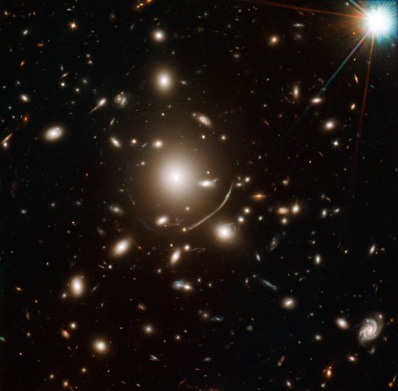



|

|

Stars born 200 million years after big bang
BY DR EMILY BALDWIN
ASTRONOMY NOW
Posted: 13 April 2011


Astronomers using the Hubble and Spitzer space telescopes, and the W. M Keck Observatory, have found a young galaxy with stars that formed just 200 million years after the big bang.
The galaxy is one of the youngest in the distant Universe to be observed with such clarity thanks to the magnifying effect of the massive cluster of galaxies, Abell 383, located in front of it, making the background galaxy appear 11 times brighter than it would without this so-called 'gravitational lensing' effect.

The magnifying effects of galaxy cluster Abell 383 were captured by the Hubble Space Telescope's Wide Field Camera 3 and the Advanced Camera for Surveys in November 2010 through March 2011. Image: NASA, ESA, J. Richard (Center for Astronomical Research/Observatory of Lyon, France), and J.-P. Kneib (Astrophysical Laboratory of Marseille, France).
“Without this big lens in space, we could not study galaxies this faint with currently available observing facilities,” says Eiichi Egami of the University of Arizona. “Thanks to nature, we have this great opportunity to see our Universe as it was eons ago.”
Identifying distant galaxies with such young stars challenges theories of how quickly galaxies sprung into existence after the big bang, but may help explain how the early Universe evolved from the so-called dark ages to a period of light. Triggered by the ignition of the first stars and galaxies, starlight flooded the Universe which ionized neutral hydrogen atoms, giving them charge. Ultraviolet light could then travel unimpeded through what had been an obscuring fog.
Pinpointing galaxies containing stars that formed only 200 million years after the big bang helps constrain this period of reionization. Numerous galaxies likely contributed to the reionization period but they are too faint to locate without the fortuitous effect of gravitational lensing. NASA’s James Webb Space Telescope (JWST), scheduled to launch later this decade, will bring these "missing" galaxies into reach.
|

|

|

|
|



